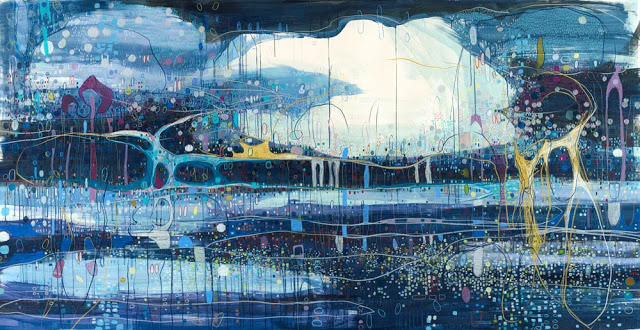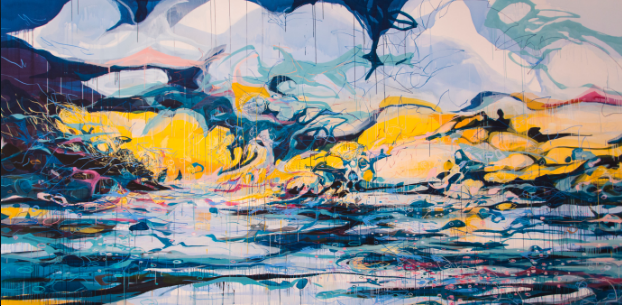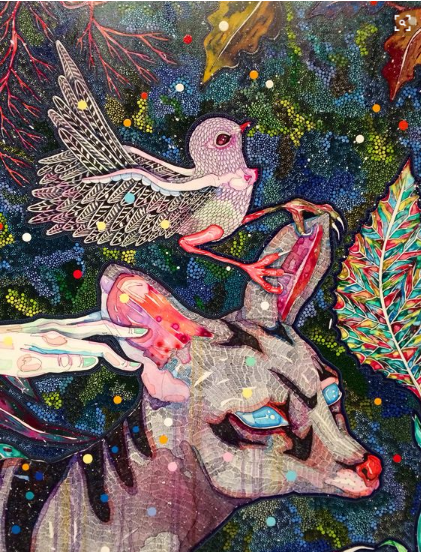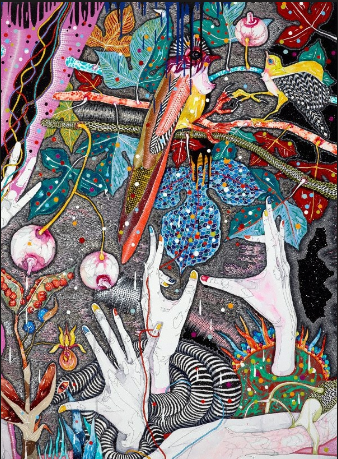One of the main qualities of visual art is that it allows people to get in touch with the surrounding physical reality through the perceptual lenses of another person’s mind – hence, making it possible for the spectators to experience the sensation of aesthetic pleasure. The derived pleasure often proves particularly intense when the art piece in question is inspired by the works of nature, or when it is concerned with depicting the natural environment.
This simply could not be otherwise – nature has always served as an important source of creative inspiration for many generations of artists. The actual explanation for this has to do with the innermost essence of art, as the instrument for amplifying the pleasurable aspects of one’s ‘experience of being’. When exposed to the elements, most people naturally grow to feel aesthetically overwhelmed – especially when surrounded by some breathtaking scenery. In its turn, this triggers several artistic anxieties in them – hence, prompting the affected individuals to consider creating art, or to act ‘artfully’.
Nevertheless, even though nature does inspire artists more or less equally, how they channel their fascination with the natural environment vary rather substantially. The most logical explanation as to why this is being the case is that just about any nature-inspired work of art is reflective of the specifics of ‘mental wiring, on the part of its creator. What this means is that it is possible to experience the aesthetic thrill of observing ‘nature art’, and to gain certain insights into the innermost workings of the affiliated artist’s mentality. To substantiate the validity of this suggestion, I will discuss some nature-depicting paintings by Janaina Tschape and Katherine Del Barton.
Janaina Tschape is a German-born artist, who had spent her formative years in Brazil, and who now resides in New York. She is known for her willingness to experiment with the innovative artistic techniques, as well as for the prominent impressionist quality of many of her artworks. Tschape’s painting Winter stands out as a perfect example in this respect.

Even a glance at this artwork will reveal that by working on it, the artist was the least concerned with trying to ensure the lifelikeness of what is being depicted. Rather, she strived to provide the visualization of the whole range of her feelings, invoked by the snowy weather outside of the window. Partially, this explains a certain nebulosity of the author’s artistic representations of a cloudy sky, trees, water in the river, bridge, and some watery streaks on the window.
After all, it does take some time observing Tschape’s painting to realize that the cloud-like objects in the artwork’s upper part are indeed clouds and not the crowns of some trees, for example. This, however, is exactly what contributes towards strengthening the impression that the depicted objects are in a state of some elusive motion. The unmistakably ‘cold’ palette of the featured colors does its work helping to establish a proper perceptual mood in onlookers.
Tschape did not merely strive to ‘catch the moment’ while creating this painting, but also to present its discursive motifs being inseparable from her sense of individuality – hence, the earlier mentioned impressionist appearance of the analyzed art piece. In a certain sense, the artist’s personality is being objectified within the compositional elements of the painting, which implies that Winter is as much about the author herself, as it is about the portrayal of the snowy landscape in the distance. Essentially the same applies to Tschape’s other painting Clouds.

As we can see in it, the depicted clouds resemble the real ones only formally. However, while exposed to this painting, one is likely to experience the realistic sensation of standing under the cloudy sky. Just as it is the case with the earlier mentioned painting, Clouds presents viewers with the strongly personalized artistic account of nature – hence, the presence of bright yellow color amidst the otherwise ‘cold’ ones. In the painting, they codify the hidden ‘clusters of meaning’, which the audience members are expected to be able to ‘decipher’. It is namely while ‘deciphering’ the artwork’s implicit semiotics that viewers can experience the feeling of aesthetic excitement. This excitement will prove particularly intense in those individuals who know a thing or two about the theory of art.
In light of what has been said earlier, it will be appropriate to suggest that Tschape tends to use the images of nature in her works as the vehicles for promoting her own highly subjective understanding of what accounts for the effects of one’s exposure to the surrounding natural environment on the formation of his or her attitudes towards life. Thus, it will only be logical to assume that Tschape’s interrelationship with nature is marked by the artist’s unconscious tendency to think of nature’s expressions as such that serve the purpose of helping her become increasingly enlightened, as to what accounts for human life.
For Tschape, nature is much more of an abstract idea of some omnipresent potency than merely the object of one’s aesthetic admiration. This provides us with a rationale to suggest that both paintings reflect the aesthetic workings of Tschape’s ‘Faustian’ psyche – the artist regards nature to be the actual key to discovering the innate principles of how the universe operates, even without being aware of it consciously. Therefore, there is nothing too odd about the apparent whimsicalness of the artist’s style – it is yet another indication of Tschape’s innate predisposition towards trying to achieve some sort of intellectual enlightenment by the mean of subjecting the surrounding nature to her emotionally driven aesthetic inquiry.
The artworks of Del Kathryn Barton (an Australian artist, who lives in Sydney) are concerned with the deployment of the entirely different methodological approach to depicting nature, as compared to that of Tschape. The most notable difference in this regard is that whereas the works of the latter connote ‘motion’, Barton’s paintings are best described as ‘motionless’, in the representational sense of this word.
Partially, this can be explained by the reference being made to the technical details of how Barton’s artistic masterpieces come into being, “Her (Barton’s) paintings show an obsession with meticulous mark-making; from minuscule dotting to veins on leaves and strands of hair. Being that the production process for her larger paintings is extremely labor-intensive”. To exemplify that this is indeed the case, we can refer to the artist’s painting Animals, as seen below.

What immediately comes into one’s eye, regarding the subtleties of Barton’s artistic style, is that they are strongly ornamental. That is, the author made a deliberate point of using bright colors to increase the anthropomorphic appeal of the depicted animals – the aesthetic technique commonly used by the Aboriginal people in Australia. The impression that Barton’s artwork was indeed inspired by the legacy of Aboriginal art is strengthened even further by the visual and thematic idealization of nature, achieved through the application of the tiny bits of paint to the canvas throughout its entirety.
Given the sheer amount of time, required to create artworks like Animals, the discussed painting cannot be deemed quite as spontaneous and ‘moody’, as it is the case with Tschape’s Winter and Clouds. At the same time, however, there are a few similarities between the aesthetic strategies of both artists. The most distinctive of them is that, just as it appears to be the case with Tschape, Barton tends to treat the emanations of nature as being highly symbolical and allegorical. The artist’s painting Birds can be considered as yet another proof in this regard.

That is, nature for Barton is more of an abstract idea than something that can be experienced and enjoyed as a ‘thing in itself’. While observing Barton’s art, people are also required to solve a mental puzzle as to what accounts for the proper approach to interpreting this art’s symbolical denotations. Thanks to the artist, there is nothing too challenging about the task. The pale coloring of human hands (one of the compositional elements in both Barton’s paintings), as well as how they are portrayed, implies that Barton uses her art as a medium for channeling the message of environmental friendliness to people. According to this message, people must aspire to live in perfect harmony with nature.
There is, however, even more to it. As it can be confirmed regarding the mentioned paintings by Barton, just about every depicted object in them is shown visually interlocking with the rest, which results in increasing the measure of both paintings’ holistic integrity. This specific effect is brought about by the fact that, despite the elaborative detailing of each component in Barton’s paintings, all of the featured elements (including the tiniest ones) are perceived as the integral parts of a whole.
Therefore, there is nothing accidental about the presence of Aboriginal motifs in Barton’s artworks – the specifics of the artist’s conceptualization of nature correlates well with the provisions of Non-Western ‘perceptual holism’, which stands in opposition to the Western (object-oriented) outlook on the natural environment and one’s place in it.
Thus, there is indeed a good reason to believe that the significance of a particular artistic representation of nature should be discussed in conjunction with what accounts for the affiliated artist’s psycho-cognitive predispositions, which define the qualitative aspects of this person’s aesthetic stance. This concluding remark is fully consistent with the paper’s initial thesis. There can be no ‘pure art’ – just about every form of artistic expression is symptomatic of its originator’s psychological predilection – just as it was implied in the paper’s introductory part.
One of this conclusion’s possible implications is that, as time goes on, the positivist theories of art, based on the assumption that there are universally recognized ‘canons’ in the artistic domain, will continue to fall out of favor with more and more people. The dialectical laws of history predetermine such an eventual development.
Bibliography
Chakravarty, Ambar. “The Neural Circuitry of Visual Artistic Production and Appreciation: A Proposition.” Annals of Indian Academy of Neurology 15, no. 2 (2012): 71-75.
Currie, Gregory. “Actual Art, Possible Art, and Art’s Definition.” The Journal of Aesthetics and Art Criticism 68, no. 3 (2010): 235-241.
Davey, E. R. “‘Soft Framing’: A Comparative Aesthetics of Painting and Photography.” Journal of European Studies 30, no. 118 (2000): 133-155.
De Lorenzo, Catherine. “The Hang and Art History.” Journal of Art Historiography no. 13 (2015): 1-17.
Galenson, David. “The Life Cycles of Modern Artists: Theory and Implications.” Historical Methods 37, no. 3 (2004): 123-136.
Hawkins, Celeste. “Del Kathryn Barton.” The Art and the Curious, 2015. Web.
Leslie, Donna. “Seeing the Natural World Art & Reconciliation.” Art Monthly Australia no. 258 (2013): 30-33.
McClelland, Kenneth. “John Dewey: Aesthetic Experience and Artful Conduct Education and Culture.” Education and Culture 21, no. 2 (2005): 44-62.
Murphy, Margueritte. “Pure Art, Pure Desire: Changing Definitions of l’Art Pour l’Art from Kant to Gautier.” Studies in Romanticism 47, no. 2 (2008): 147-160.
Pearse, Emma. “Janaina Tschape.” ARTnews 104, no. 9 (2005): 184-185.
Tekiner, Deniz. “Formalist Art Criticism and the Politics of Meaning.” Social Justice 33, no. 2 (2006): 31-44.
Thomas, Daniel. “Aboriginal Art: Who Was Interested?” Journal of Art Historiography no. 4 (2011): 1-10.
Vasilenko, Ivan. “Dialogue of Cultures, Dialogue of Civilizations.” Russian Social Science Review 41, no. 2 (2000): 5-22.
Wilson, Henry. “Pleasure Palettes.” World of Interiors 30, no. 1 (2010): 58-67.
Young, Michael. “Del Kathryn Barton: Disco Darling.” Art and AsiaPacific no. 96 (2015): 68-69.